Buy Parts for your Dacor Wall Oven
To learn more about your range/stove/oven, or to order parts, clickhere.

Buy Parts for your Dacor Wall Oven
To learn more about your range/stove/oven, or to order parts, clickhere.
A common problem you run into when working on older appliances is that the schematic and wiring diagram are missing– usually because the slimeball who worked on it before you stole it. This happened recently to a tech in the Samurai Appliance Repair Forum where Sublime Master of Appliantology Pegi was able to locate it for him. Such is the power of the forum! In his case, he needed diagrams for a GE JKP36G004BG double wall oven. They’re posted below; if you need it, go ahead and download it.
Schematic and Wiring Diagram for the GE JKP36G004BG Oven
To learn more about your range/stove/oven, or to order parts, click here
(Also applies to Kenmore washers with a model number prefix of 417.)
Note: Begin troubleshooting a no-spin condition by checking the door latch switch. If it checks good, then proceed with this flowchart. See the tech sheet with your washer for the door latch switch test procedure. The procedures described below assume that the door latch switch tests good.
The most common motor problem with this washer is no-spin; the drum may tumble, but it either never goes into spin at all or or just never ramps up to high speed spin. The tech sheet supplied with the washer (inside the cabinet, in a big envelope pasted to an inside wall– remove bottom front quarter panel to get to it) gives troubleshooting instructions but they are poorly written and difficult to follow, even for sage and battle-hardened appliantologists. The troubleshooting flowchart below from the service manual is mo’ bettah:
As noted in the flowchart, it’s pretty rare for the motor to fail in this washer, although I have seen it. The motor winding continuity checks are done through the motor wire harness at the speed control board (for convenience). If you get an open reading there, don’t take it as gospel that the motor is bad– repeat the test at the motor itself so that you’re not reading through the motor wire harness. The wire harness itself, specifically the molex connector, is a more common troublemaker than the motor.
A more common failure item causing a no-spin condition in this washer is the speed control board.
To learn more about your washing machine, or to order parts, click here.
Been seeing a rash of galvanic corrosion-induced failures of the drum support spiders in various brands of front loading washers. Affected brands include GE, Whirlpool, and Frigidaire. Since Sears Kenmore brand outsources everything with a Kenmore label, all Kenmore washers are manufactured by one of the three aforementioned companies and will also manifest this same problem (see this topic for more info on who makes Kenmore appliances).
Kicking off the Washer Corrosion Hall of Shame is this bit of metallic misery from a Frikkidaire washer:
The drum support spider in this Frigidaire washer had corroded so much that the hub and drive shaft actually broke off. Note the pitting in the metal. You can see in the closeup that the metal seems to turn into powder. That’s the galvanic corrosion that I be tawkin’ aboot, you dig? It weakened the spider structural strength so much that it failed during use. Ah, Grasshoppah, can you stand with me, our mouths agape at the raw power of chemistry?
Next up is this drum from a GE washer:
Not to be outdone by their competitors, here’s an advanced case of galvanic corrosion in a Whirlpool Duet washer (also sold as the Kenmore HE2/3t):
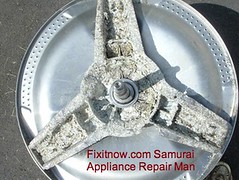
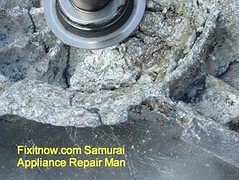
(click images for larger view)
Whence cometh this galvanic corrosion? Most likely because of dissimilar metals between the spider assembly and the drum setting up a galvanic cell inside the washer. The drum is stainless steel and the spider is aluminum. In the wet environment, the aluminum acts as a sacrificial anode, like the zinc rod in a water heater. Some combinations of detergents, fabric softeners, and water quality conditions may create electrochemical conditions which exacerbate this problem. Can you say, “Design flaw?”
I think the engineers at one of these companies figgered out a way to save a buck two-eighty by using an aluminum drum support spider and the engineers at the other companies just brainlessly copied it without applying gray matter. My Momma always telled me that stupid is as stupid does. I rectum now I see what she be sayin’.
To learn more about your washing machine, or to order parts, click here.
First thang you’ll need to do is get the serial number off the model number tag. Armed with this key information, proceed to the appropriate section below:
For Whirlpool, Kitchenaid, Roper, Estate, Maytag, and Magic Chef appliances, use the Appliance Age Finder to find out how old it is.
For GE appliances, use the table below:
For Frigidaire appliances, use this table:
Here it is, the flowchart you’ve been painfully waiting for while laying awake at night knotted up with anxiety: the Internet’s first systematic troubleshooting flowchart for the Whirlpool-built modular (that means “in your freezer”) icemaker. Go ahead, steal this pdf and share with all your friends… and your enemies, too!
To learn more about your ice maker, or to order parts, click here.
The Whirlpool-built modular icemaker is used in just about all refrigerators made today, regardless of brand. One notorious exception is the crappy IM6 icemakers used in GE-built refrigerators. Why they didn’t just go with the field-tested Whirlpool-built units is a seedy story of corporate sleaze and extortion now playing in a theater near you!
Any-freakin-way, one of the basic diagnostic things you’ll do on these Whirlpool-built modular icemakers is to manually start the harvest cycle. This is useful for finding out reasons why the icemaker isn’t working. For example, it may not start the harvest cycle at all: bad control module. Or you may find that water never comes in: could be a frozen fill tube, bad water inlet valve, bad water supply.
“O mighty Samurai,” you ax, with stars in your eyes, “how does a neophyte on the path of higher Appliantological wisdom accomplish this miracle of initiating the harvest cycle of which thou speakest?”
An astute question, my fine, young apprentice, and elegantly phrased. Behold the revelation of the mystery:
To initiate the harvest cycle: use an insulated length of wire with about a half inch stripped off each end. Insert each end of the wire into the test points marked T and H, as shown above. You’ll see the icemaker rake arm begin to move. In just a few seconds– if you listen real close-like– you’ll hear a faint “click,” that means you can pull the jumper wire out and the harvest cycle will continue all by itself.
Ahh, Grasshoppah, can you snatch this pebble from my hand?
To learn more about your ice maker, or to order parts, click here.
Looking for an easy way to destroy the pump in your Whirlpool Duet Sport washing machine? Piece of pie, tovarish! Just don’t empty your pockets before you put your pants in the laundry hamper.
You’ll soon overload the pump’s gookus catcher and some of it is bound to get through and destroy the pump.
Persistence pays…
… about $130 in this case. Yep, that’s what a new pump for this beast will run ya, Slick. And it even includes instamalation destructions, too, at no extra charge! Y’see, Hoss, here at Fixit-the-freak-now-dot-frikkin-com, we’re always scoping the deals for you ‘cuz it’s all about you.
Replacing the pump is easy enough… once you clear all the water. Since the pump ain’t working on account of all that metal detector fodder in your pockets, the tub will be full of water. Bail as much as you can. Then remove the kickplate– three screws on the very bottom, cheek to the floor, you’ll see ’em. See that big accordion-looking rubber thingy behind the pump? That’s the suction boot. You’ll need to remove that from the pump. It’s jobs like this where you discover why God gave man Shop Vacs. There’ll be residual water in the drum that’ll run out all over the place unless you suck it up with the Shop Vac as you ease the suction boot off the pump ever so gently. It’s a technique kind of a deal. After you do a few hundred of these, you’ll get to where you won’t even spill a drop… of blood or water.
To learn more about your washing machine, or to order parts, click here.
Behold:
I’ve even seen this problem accompanied by dramatic, poltergeist-looking light dimming. Very cool!
The problem is the motor. In fact, this clicking and chugging problem was so common on this washer (example model number WBSE3120B) that GE put out a repair kit for it. The kit includes the motor and clutch (pre-assembled), wiring harness, capacitor, wire connecting goodies, and even a tri-lingual notification tag as a double-extra special bonus. Come git you one!
To learn more about your washing machine, or to order parts, click here.
To learn more about your range/stove/oven, or to order parts, click here.
John wrote:
I need to buy all new kitchen and laundry appliances. Which brand would you stick with (Samsung, LG, Whirlpool, Maytag). I am looking for a frenchdoor and all appliances should match…Stainless too.
Thanks,
John
Let us open our Appliantology hymnals to the Second Law of the Prophecy wherein it is written, “All appliances break.” With this wisdom firmly implanted in that muck betwixt our ears, we begin to see your question from a new perspective.
Like so many propagandized Ameedicans victimized by the slick marketing campaigns assaulting us in the corporate media organs, we see that you have placed aesthetics ahead of practical considerations, such as repairability. In other words, you have placed more importance on form over function, exactly as you have been programmed to do as a good little consumer.
But fear not, my mushy-headed grasshopper, for the Samurai is here to break the spell that the marketing wizards have placed you under. Lo, with his mighty katana, he shall cut asunder the chains of your programming and free you from the trap of mindless consumerism! Let us begin by re-phrasing your question in the way the Samurai would ax it, “Knowing that all modern appliance brands and models are mediocre at best and that all fall short of the glory of the Samurai, which piece of junk am I going to have the easiest time fixing?”
Ahh, Grasshoppah, now you’re beginning to pierce the veil and to do what we professional appliantologists call, “critical thinking.” Using this new, enlightened paradigm, which emphasizes function over form and recognizes the Second Law of the Prophecy, the question further reduces to, “Which appliance manufacturers make their service manuals and technical bulletins freely and readily available to professional appliantologists as well as Joe Do-it-yourselfer?” Eggzellent question, my querying grasshoppah, domo fer axin’!
Currently, there are only three brands which make their service information freely available: Whirlpool (which includes Kitchenaid, Roper, and Maytag brands), Frigidaire (which includes Electrolux brands), and Dacor (which includes, well, just Dacor). Emphasis on the word, “currently” because Whirlpool is considering restricting access to their technical information to professional appliantologists only– you can thank the over-abundance of lawyers and the bidness-killing tort system in Ameedica for that.
At the other end of the information spectrum are companies that are very restrictive with their technical service information and, for that reason, I would never even consider buying their stuff. The worst offenders in the infowar are Viking and GE. In the case of Viking, they’re not only tight-fisted with their service manuals, but their ranges are the shoddiest on the market. And you get to pay a premium price tag just to have the “Viking” badge in your kitchen. Viking is the poster boy of what I mean by placing form over function.
Awwite, armed with this sacred wisdom and enlightened perspective, gird up thy loins and go git ’em!
… and to make your joy complete, GE has discontinued this two-year old model! Can you say, “Uhh, guys, we better stop production on this pig-dog before we get our bee-hinds sued into oblivion.” Uh-huh, that’s what I thought you said. Anyway, this topic in the Samurai Appliance Repair Forums ‘splains what you need to fix it…
GE Microwave Melting Door and Burning Smell
To learn more about your microwave oven, or to order parts, click here.
Had the opportunity to work on an antique the other day: a 30+ year old Whirlpool stack laundry unit with a belt drive washer. This old work horse was still chugging along, just needed a new lid switch. In terms of durability and reliability, you’ll not find anything even close to this machine these days. Just pray to the pot-bellied, bug-eyed Buddha that you never have to replace the belt on this old war pig!
While I was in there, I got some pictures of the innards. Come tiptoe thru the pulleys with me…
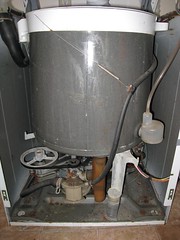 Basic View with Front Panel Removed
Basic View with Front Panel Removed
BTW, you can click the pics for the larger view with illuminating annotations.
Live Action Movie!
If you watch closely, you’ll see the legendary wigwag in action.
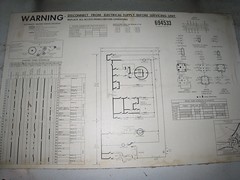 Schematic – Pasted Inside the Panel
Schematic – Pasted Inside the Panel
To learn more about your washing machine, or to order parts, click here.
All gas appliances have (or are supposed to have) a manual shutoff valve in the gas supply line near the appliance so the gas can be shut off to just that appliance without having to shutoff the gas to entire house. But how do you know whether the valve is on or off? Behold:
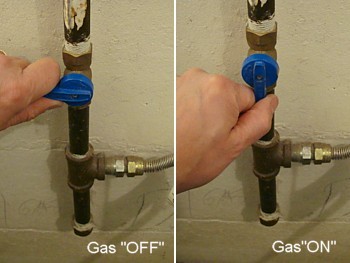
Awwite, now listen up: this post applies to the older style Whirlpool / Kitchenaid dishwashers (yes, Kitchenaid is a Whirlpool brand– it’s supposedly Whirlpool’s higher end line) with the motor-pump assembly that looks like this. An example model number is kuds25shwh1. If the motor-pump assembly in your Whirlpool or Kitchenaid dishwasher looks like this, then you’re reading the wrong post; you need this one.
Here’s a typical problem description: the dishwasher will program to wash, it fills, the sensing light comes on, and then just sits there forever. If you hit reset, the motor comes on to pump out. But the motor never turns on to wash.
Since this dishwasher does not have a separate drain pump– it drains by reversing the direction of the motor– you may be seduced into thinking that there’s something wrong with the motor windings, like maybe one of them is burned out. You may even go plunk down some Federal Reserve Notes for a new motor-pump assembly, go through the hassle and pain to install it, and then eat your liver when you discover that, after all that, it didn’t fix the problem. Now perhaps you’re ready to listen to an old Samurai.
Let’s use that swirling muck betwixt our ears for something besides warehousing vaccine neurotoxins. For the motor to run, it needs a valid power supply, in this case, 120vac. So, if the motor isn’t running, your first question should be, “Is the motor getting voltage?”
To check this, you’ll need the wiring diagram (located behind the kickplates in a plastic pouch) and your voltage sensing light stick. When the dishwasher is in wash mode– and should be washing but ain’t– then put your light stick on the wires to the motor. No light, no voltage. Therefore the motor ain’t the problem; you got yourself a control problem.
You can get real anal retentive at this point and check the continuity of the wires going to the motor to make sure they’re all good. Or you can just heed the voice of experience telling you that the problem is almost always the control board (item 19). Easy job, just be sure to cut the breaker to the dishwasher before tearing the control panel apart. Conveniently, you can buy the control board ratcheer!
To learn more about your dishwasher, or to order parts, click here.